Investigation of Big Data Applications and Technologies in Healthcare
VerifiedAdded on 2022/12/26
|17
|3412
|95
Report
AI Summary
This report provides a comprehensive overview of big data applications and technologies within the healthcare sector. It begins with an investigation into the use of big data, highlighting its significance and prevalence in the industry. The report then delves into specific applications such as Electronic Health Records (EHRs), real-time alerting systems, and predictive analytics, detailing their functionalities and benefits. Furthermore, it discusses various big data technologies including Hadoop, NoSQL, data lakes, and in-memory databases, explaining their roles and contributions. The report also identifies key challenges in the healthcare sector, particularly those related to data governance, and proposes solutions for addressing these issues. By examining these aspects, the report aims to offer a thorough understanding of how big data is transforming healthcare and improving patient care.

Paraphrase This Document
Need a fresh take? Get an instant paraphrase of this document with our AI Paraphraser
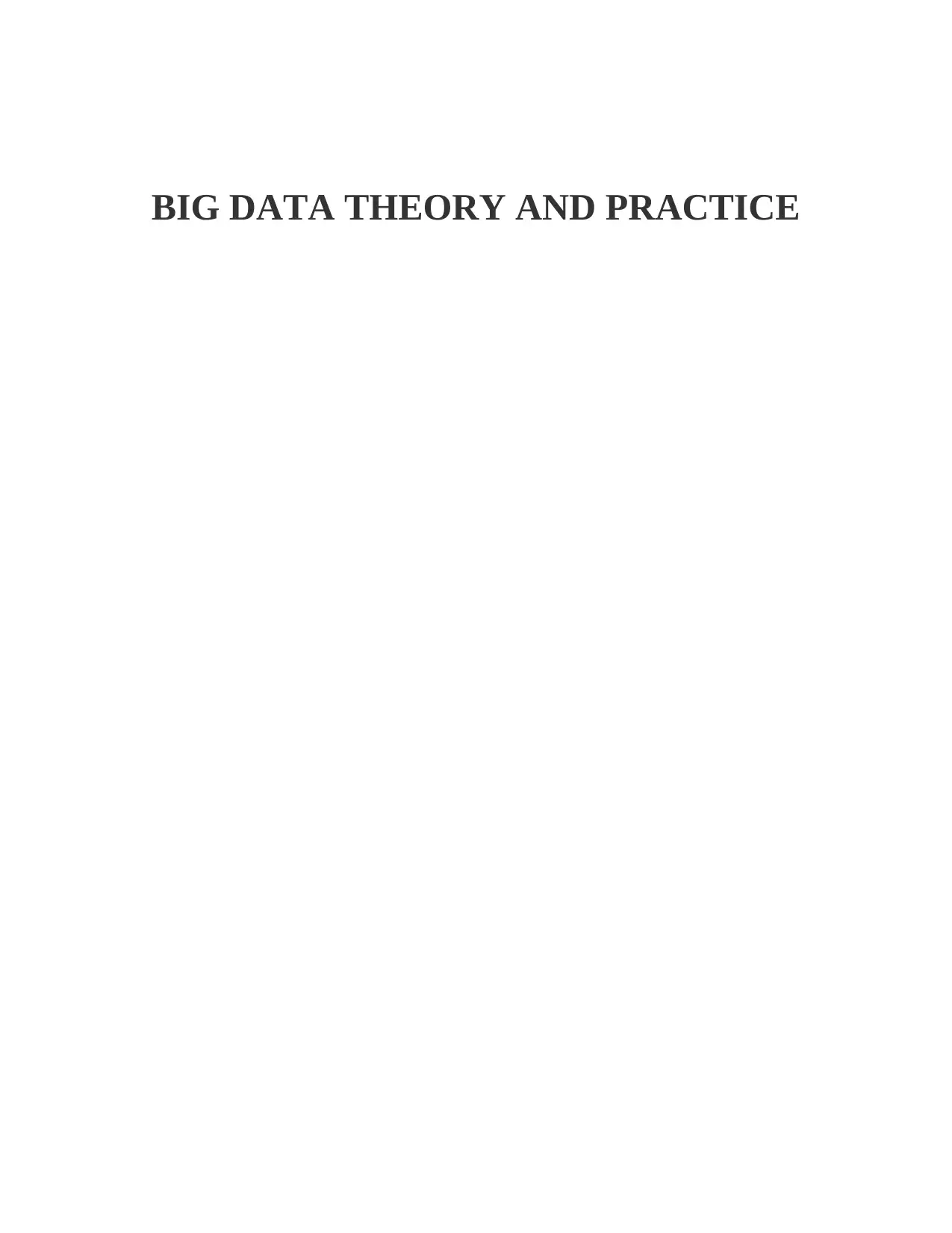
BIG DATA THEORY AND PRACTICE
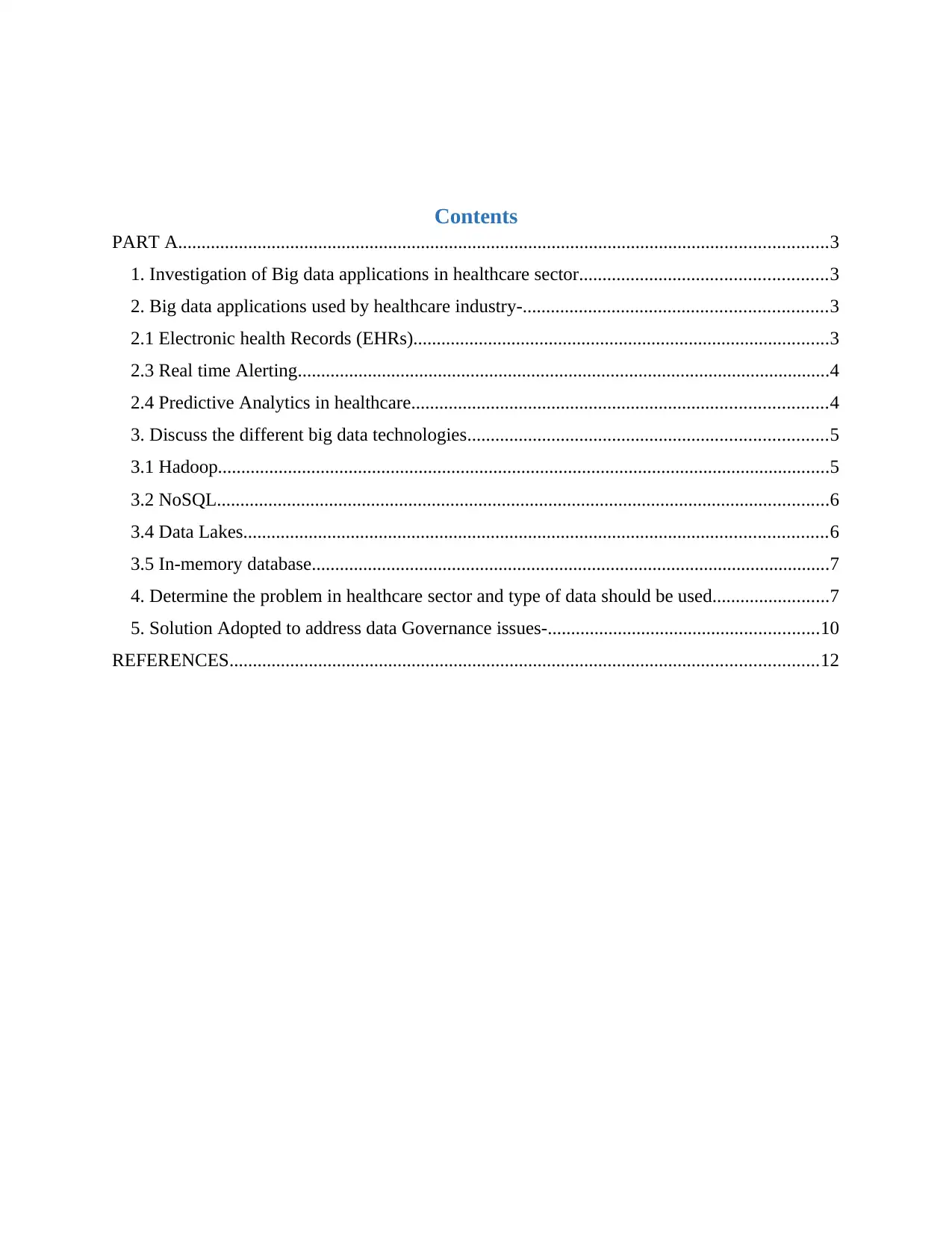
Contents
PART A...........................................................................................................................................3
1. Investigation of Big data applications in healthcare sector.....................................................3
2. Big data applications used by healthcare industry-.................................................................3
2.1 Electronic health Records (EHRs).........................................................................................3
2.3 Real time Alerting..................................................................................................................4
2.4 Predictive Analytics in healthcare.........................................................................................4
3. Discuss the different big data technologies.............................................................................5
3.1 Hadoop...................................................................................................................................5
3.2 NoSQL...................................................................................................................................6
3.4 Data Lakes.............................................................................................................................6
3.5 In-memory database...............................................................................................................7
4. Determine the problem in healthcare sector and type of data should be used.........................7
5. Solution Adopted to address data Governance issues-..........................................................10
REFERENCES..............................................................................................................................12
PART A...........................................................................................................................................3
1. Investigation of Big data applications in healthcare sector.....................................................3
2. Big data applications used by healthcare industry-.................................................................3
2.1 Electronic health Records (EHRs).........................................................................................3
2.3 Real time Alerting..................................................................................................................4
2.4 Predictive Analytics in healthcare.........................................................................................4
3. Discuss the different big data technologies.............................................................................5
3.1 Hadoop...................................................................................................................................5
3.2 NoSQL...................................................................................................................................6
3.4 Data Lakes.............................................................................................................................6
3.5 In-memory database...............................................................................................................7
4. Determine the problem in healthcare sector and type of data should be used.........................7
5. Solution Adopted to address data Governance issues-..........................................................10
REFERENCES..............................................................................................................................12
⊘ This is a preview!⊘
Do you want full access?
Subscribe today to unlock all pages.

Trusted by 1+ million students worldwide

Table of figures
Figure 1 Electronic health Records process.....................................................................................2
Figure 2 predicting the use of Analytics in healthcare....................................................................3
Figure 1 Electronic health Records process.....................................................................................2
Figure 2 predicting the use of Analytics in healthcare....................................................................3
Paraphrase This Document
Need a fresh take? Get an instant paraphrase of this document with our AI Paraphraser
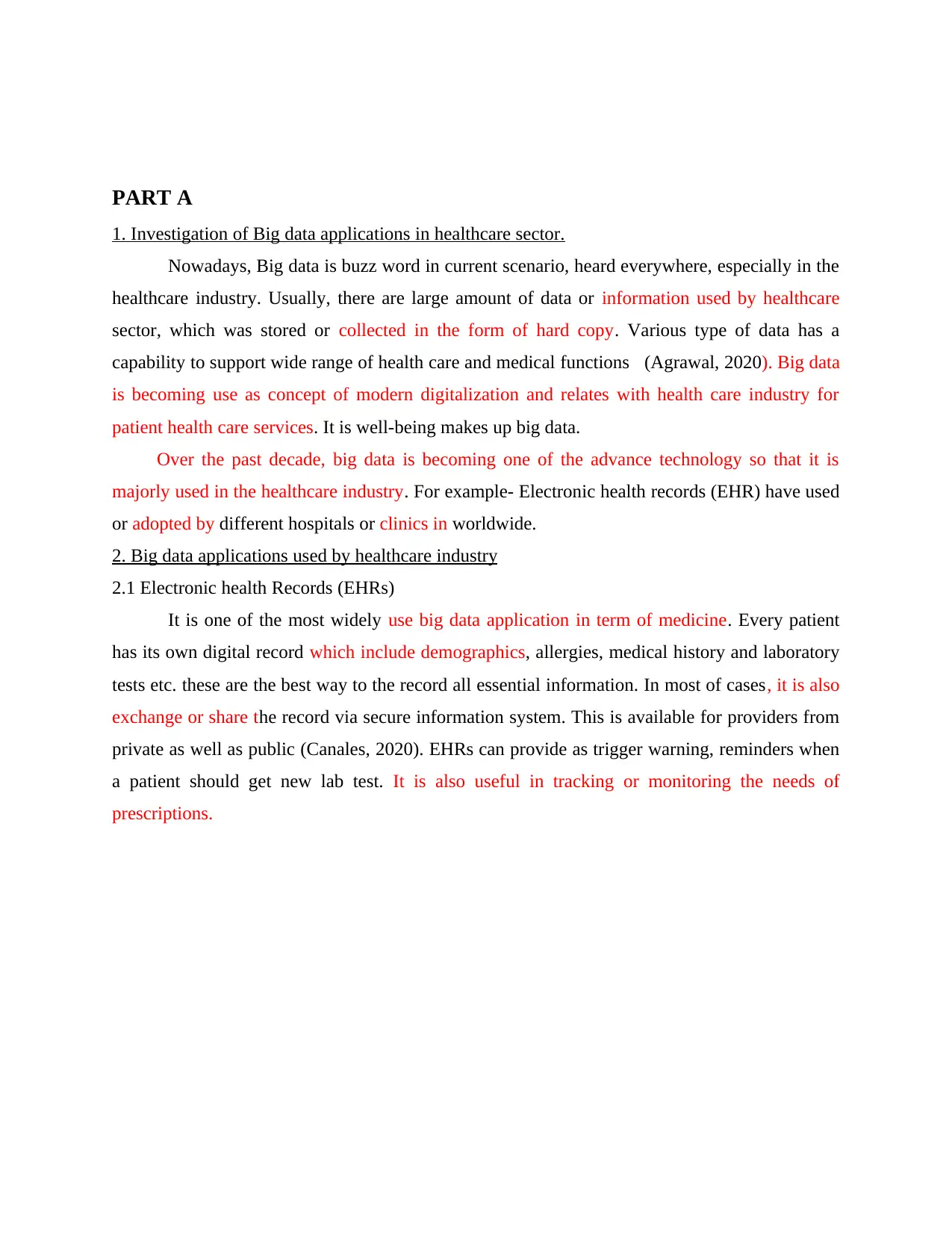
PART A
1. Investigation of Big data applications in healthcare sector.
Nowadays, Big data is buzz word in current scenario, heard everywhere, especially in the
healthcare industry. Usually, there are large amount of data or information used by healthcare
sector, which was stored or collected in the form of hard copy. Various type of data has a
capability to support wide range of health care and medical functions (Agrawal, 2020). Big data
is becoming use as concept of modern digitalization and relates with health care industry for
patient health care services. It is well-being makes up big data.
Over the past decade, big data is becoming one of the advance technology so that it is
majorly used in the healthcare industry. For example- Electronic health records (EHR) have used
or adopted by different hospitals or clinics in worldwide.
2. Big data applications used by healthcare industry
2.1 Electronic health Records (EHRs)
It is one of the most widely use big data application in term of medicine. Every patient
has its own digital record which include demographics, allergies, medical history and laboratory
tests etc. these are the best way to the record all essential information. In most of cases, it is also
exchange or share the record via secure information system. This is available for providers from
private as well as public (Canales, 2020). EHRs can provide as trigger warning, reminders when
a patient should get new lab test. It is also useful in tracking or monitoring the needs of
prescriptions.
1. Investigation of Big data applications in healthcare sector.
Nowadays, Big data is buzz word in current scenario, heard everywhere, especially in the
healthcare industry. Usually, there are large amount of data or information used by healthcare
sector, which was stored or collected in the form of hard copy. Various type of data has a
capability to support wide range of health care and medical functions (Agrawal, 2020). Big data
is becoming use as concept of modern digitalization and relates with health care industry for
patient health care services. It is well-being makes up big data.
Over the past decade, big data is becoming one of the advance technology so that it is
majorly used in the healthcare industry. For example- Electronic health records (EHR) have used
or adopted by different hospitals or clinics in worldwide.
2. Big data applications used by healthcare industry
2.1 Electronic health Records (EHRs)
It is one of the most widely use big data application in term of medicine. Every patient
has its own digital record which include demographics, allergies, medical history and laboratory
tests etc. these are the best way to the record all essential information. In most of cases, it is also
exchange or share the record via secure information system. This is available for providers from
private as well as public (Canales, 2020). EHRs can provide as trigger warning, reminders when
a patient should get new lab test. It is also useful in tracking or monitoring the needs of
prescriptions.
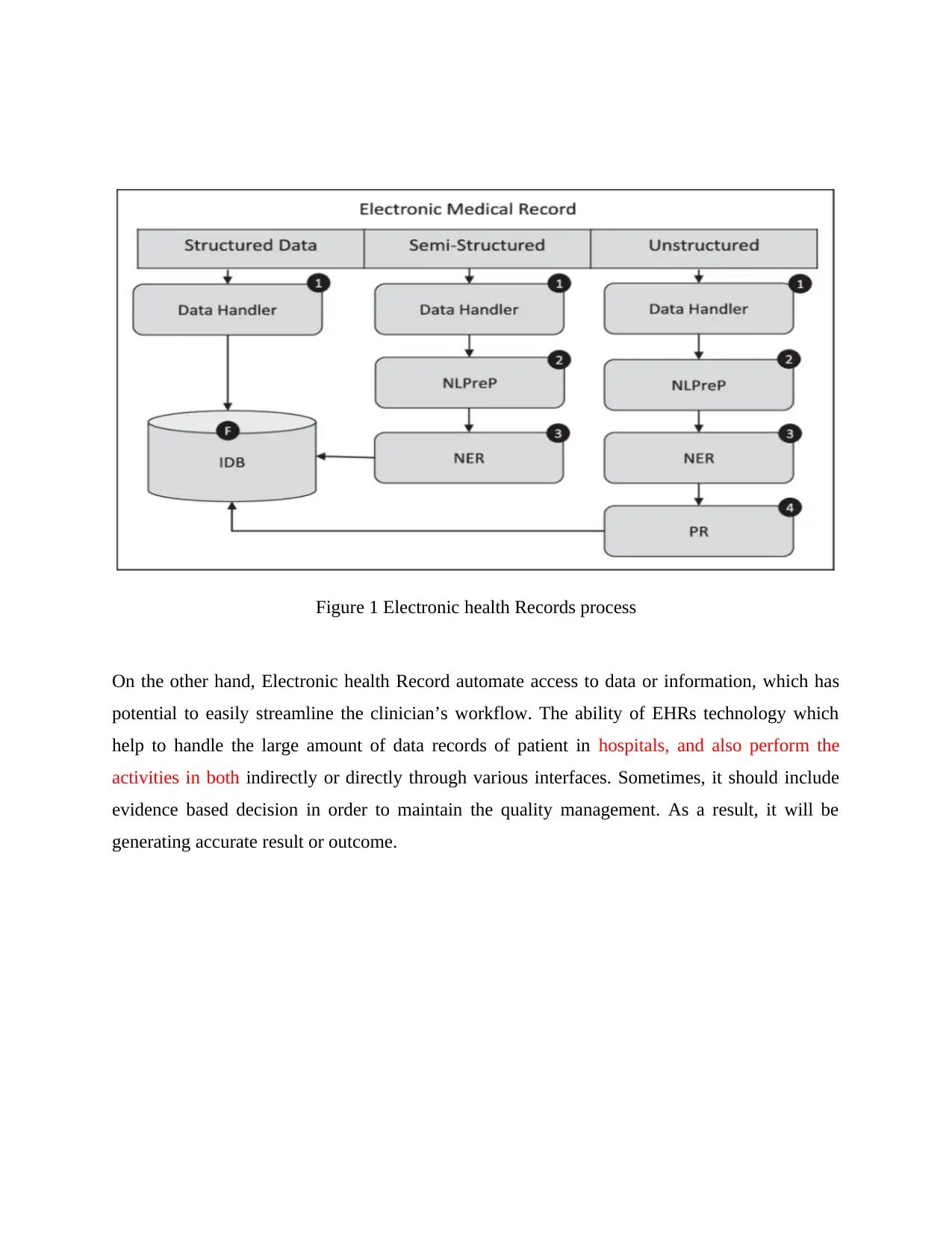
Figure 1 Electronic health Records process
On the other hand, Electronic health Record automate access to data or information, which has
potential to easily streamline the clinician’s workflow. The ability of EHRs technology which
help to handle the large amount of data records of patient in hospitals, and also perform the
activities in both indirectly or directly through various interfaces. Sometimes, it should include
evidence based decision in order to maintain the quality management. As a result, it will be
generating accurate result or outcome.
On the other hand, Electronic health Record automate access to data or information, which has
potential to easily streamline the clinician’s workflow. The ability of EHRs technology which
help to handle the large amount of data records of patient in hospitals, and also perform the
activities in both indirectly or directly through various interfaces. Sometimes, it should include
evidence based decision in order to maintain the quality management. As a result, it will be
generating accurate result or outcome.
⊘ This is a preview!⊘
Do you want full access?
Subscribe today to unlock all pages.

Trusted by 1+ million students worldwide
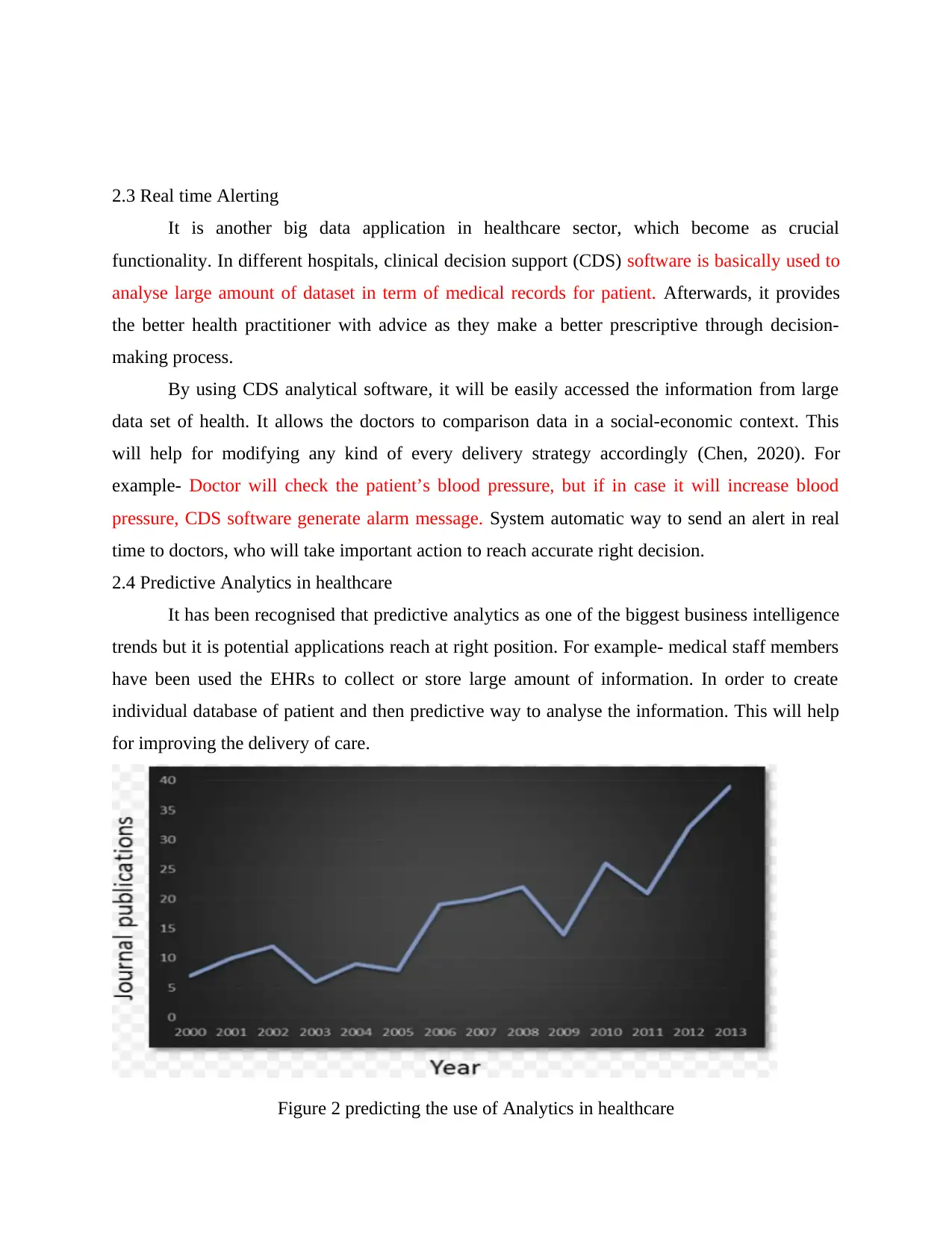
2.3 Real time Alerting
It is another big data application in healthcare sector, which become as crucial
functionality. In different hospitals, clinical decision support (CDS) software is basically used to
analyse large amount of dataset in term of medical records for patient. Afterwards, it provides
the better health practitioner with advice as they make a better prescriptive through decision-
making process.
By using CDS analytical software, it will be easily accessed the information from large
data set of health. It allows the doctors to comparison data in a social-economic context. This
will help for modifying any kind of every delivery strategy accordingly (Chen, 2020). For
example- Doctor will check the patient’s blood pressure, but if in case it will increase blood
pressure, CDS software generate alarm message. System automatic way to send an alert in real
time to doctors, who will take important action to reach accurate right decision.
2.4 Predictive Analytics in healthcare
It has been recognised that predictive analytics as one of the biggest business intelligence
trends but it is potential applications reach at right position. For example- medical staff members
have been used the EHRs to collect or store large amount of information. In order to create
individual database of patient and then predictive way to analyse the information. This will help
for improving the delivery of care.
Figure 2 predicting the use of Analytics in healthcare
It is another big data application in healthcare sector, which become as crucial
functionality. In different hospitals, clinical decision support (CDS) software is basically used to
analyse large amount of dataset in term of medical records for patient. Afterwards, it provides
the better health practitioner with advice as they make a better prescriptive through decision-
making process.
By using CDS analytical software, it will be easily accessed the information from large
data set of health. It allows the doctors to comparison data in a social-economic context. This
will help for modifying any kind of every delivery strategy accordingly (Chen, 2020). For
example- Doctor will check the patient’s blood pressure, but if in case it will increase blood
pressure, CDS software generate alarm message. System automatic way to send an alert in real
time to doctors, who will take important action to reach accurate right decision.
2.4 Predictive Analytics in healthcare
It has been recognised that predictive analytics as one of the biggest business intelligence
trends but it is potential applications reach at right position. For example- medical staff members
have been used the EHRs to collect or store large amount of information. In order to create
individual database of patient and then predictive way to analyse the information. This will help
for improving the delivery of care.
Figure 2 predicting the use of Analytics in healthcare
Paraphrase This Document
Need a fresh take? Get an instant paraphrase of this document with our AI Paraphraser
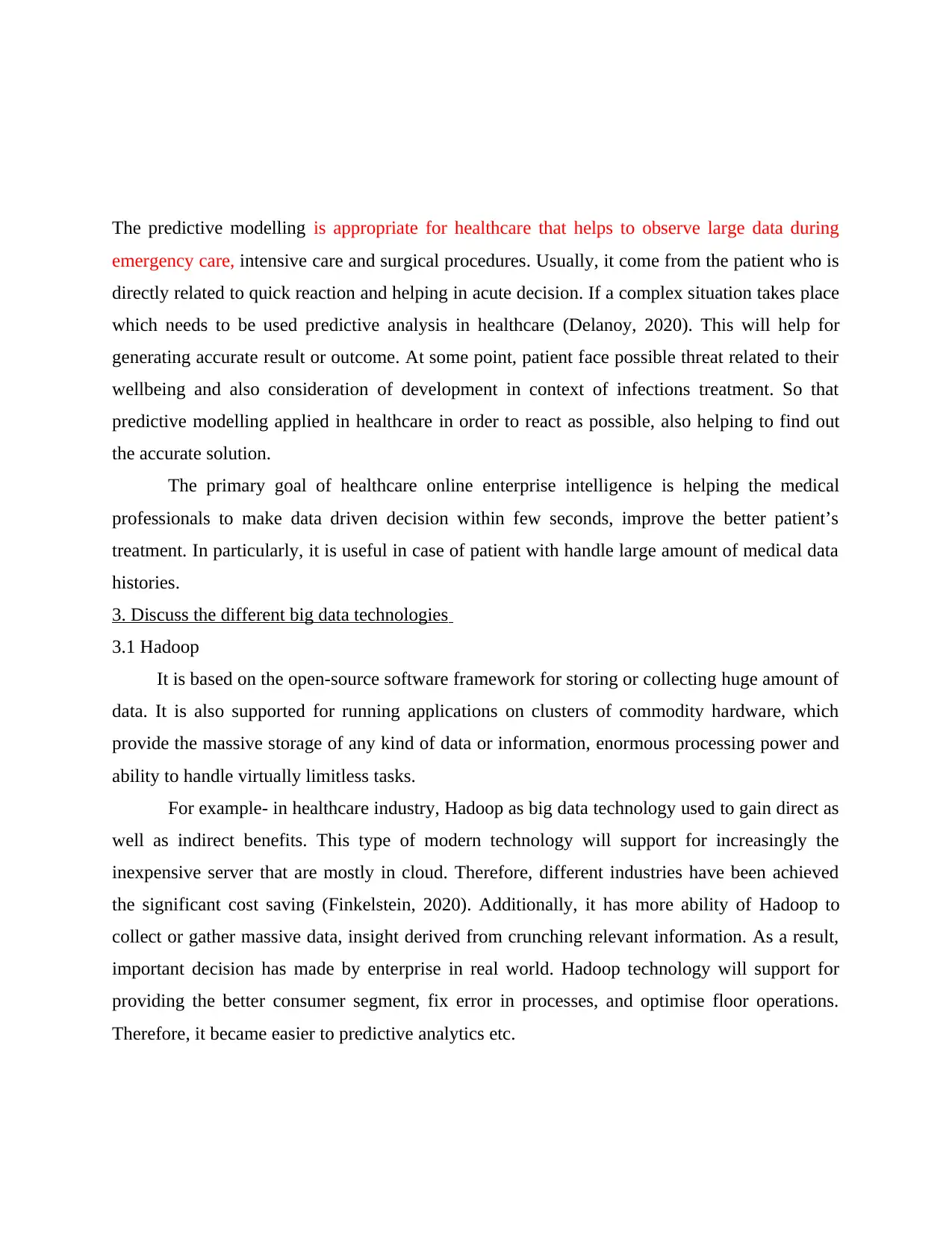
The predictive modelling is appropriate for healthcare that helps to observe large data during
emergency care, intensive care and surgical procedures. Usually, it come from the patient who is
directly related to quick reaction and helping in acute decision. If a complex situation takes place
which needs to be used predictive analysis in healthcare (Delanoy, 2020). This will help for
generating accurate result or outcome. At some point, patient face possible threat related to their
wellbeing and also consideration of development in context of infections treatment. So that
predictive modelling applied in healthcare in order to react as possible, also helping to find out
the accurate solution.
The primary goal of healthcare online enterprise intelligence is helping the medical
professionals to make data driven decision within few seconds, improve the better patient’s
treatment. In particularly, it is useful in case of patient with handle large amount of medical data
histories.
3. Discuss the different big data technologies
3.1 Hadoop
It is based on the open-source software framework for storing or collecting huge amount of
data. It is also supported for running applications on clusters of commodity hardware, which
provide the massive storage of any kind of data or information, enormous processing power and
ability to handle virtually limitless tasks.
For example- in healthcare industry, Hadoop as big data technology used to gain direct as
well as indirect benefits. This type of modern technology will support for increasingly the
inexpensive server that are mostly in cloud. Therefore, different industries have been achieved
the significant cost saving (Finkelstein, 2020). Additionally, it has more ability of Hadoop to
collect or gather massive data, insight derived from crunching relevant information. As a result,
important decision has made by enterprise in real world. Hadoop technology will support for
providing the better consumer segment, fix error in processes, and optimise floor operations.
Therefore, it became easier to predictive analytics etc.
emergency care, intensive care and surgical procedures. Usually, it come from the patient who is
directly related to quick reaction and helping in acute decision. If a complex situation takes place
which needs to be used predictive analysis in healthcare (Delanoy, 2020). This will help for
generating accurate result or outcome. At some point, patient face possible threat related to their
wellbeing and also consideration of development in context of infections treatment. So that
predictive modelling applied in healthcare in order to react as possible, also helping to find out
the accurate solution.
The primary goal of healthcare online enterprise intelligence is helping the medical
professionals to make data driven decision within few seconds, improve the better patient’s
treatment. In particularly, it is useful in case of patient with handle large amount of medical data
histories.
3. Discuss the different big data technologies
3.1 Hadoop
It is based on the open-source software framework for storing or collecting huge amount of
data. It is also supported for running applications on clusters of commodity hardware, which
provide the massive storage of any kind of data or information, enormous processing power and
ability to handle virtually limitless tasks.
For example- in healthcare industry, Hadoop as big data technology used to gain direct as
well as indirect benefits. This type of modern technology will support for increasingly the
inexpensive server that are mostly in cloud. Therefore, different industries have been achieved
the significant cost saving (Finkelstein, 2020). Additionally, it has more ability of Hadoop to
collect or gather massive data, insight derived from crunching relevant information. As a result,
important decision has made by enterprise in real world. Hadoop technology will support for
providing the better consumer segment, fix error in processes, and optimise floor operations.
Therefore, it became easier to predictive analytics etc.
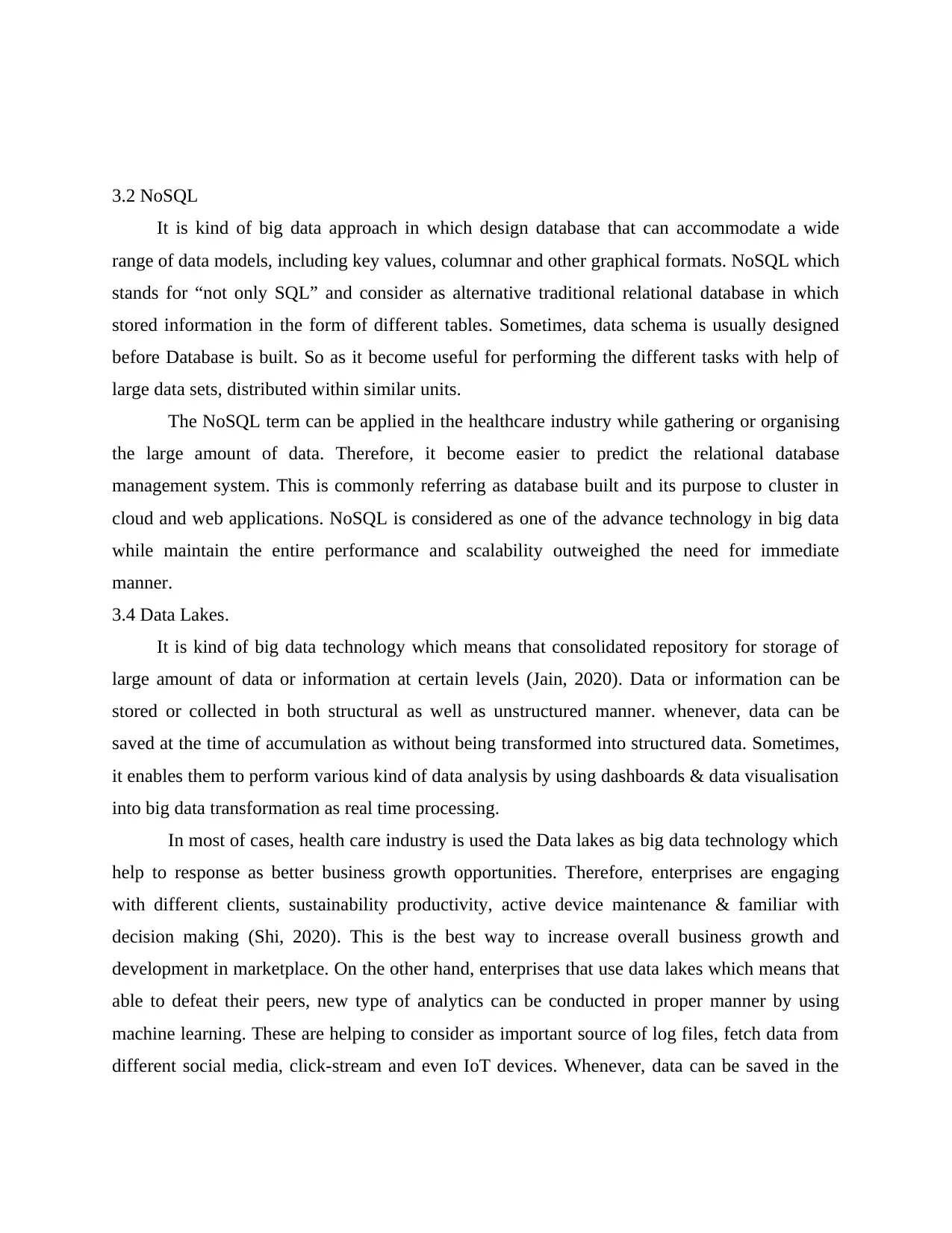
3.2 NoSQL
It is kind of big data approach in which design database that can accommodate a wide
range of data models, including key values, columnar and other graphical formats. NoSQL which
stands for “not only SQL” and consider as alternative traditional relational database in which
stored information in the form of different tables. Sometimes, data schema is usually designed
before Database is built. So as it become useful for performing the different tasks with help of
large data sets, distributed within similar units.
The NoSQL term can be applied in the healthcare industry while gathering or organising
the large amount of data. Therefore, it become easier to predict the relational database
management system. This is commonly referring as database built and its purpose to cluster in
cloud and web applications. NoSQL is considered as one of the advance technology in big data
while maintain the entire performance and scalability outweighed the need for immediate
manner.
3.4 Data Lakes.
It is kind of big data technology which means that consolidated repository for storage of
large amount of data or information at certain levels (Jain, 2020). Data or information can be
stored or collected in both structural as well as unstructured manner. whenever, data can be
saved at the time of accumulation as without being transformed into structured data. Sometimes,
it enables them to perform various kind of data analysis by using dashboards & data visualisation
into big data transformation as real time processing.
In most of cases, health care industry is used the Data lakes as big data technology which
help to response as better business growth opportunities. Therefore, enterprises are engaging
with different clients, sustainability productivity, active device maintenance & familiar with
decision making (Shi, 2020). This is the best way to increase overall business growth and
development in marketplace. On the other hand, enterprises that use data lakes which means that
able to defeat their peers, new type of analytics can be conducted in proper manner by using
machine learning. These are helping to consider as important source of log files, fetch data from
different social media, click-stream and even IoT devices. Whenever, data can be saved in the
It is kind of big data approach in which design database that can accommodate a wide
range of data models, including key values, columnar and other graphical formats. NoSQL which
stands for “not only SQL” and consider as alternative traditional relational database in which
stored information in the form of different tables. Sometimes, data schema is usually designed
before Database is built. So as it become useful for performing the different tasks with help of
large data sets, distributed within similar units.
The NoSQL term can be applied in the healthcare industry while gathering or organising
the large amount of data. Therefore, it become easier to predict the relational database
management system. This is commonly referring as database built and its purpose to cluster in
cloud and web applications. NoSQL is considered as one of the advance technology in big data
while maintain the entire performance and scalability outweighed the need for immediate
manner.
3.4 Data Lakes.
It is kind of big data technology which means that consolidated repository for storage of
large amount of data or information at certain levels (Jain, 2020). Data or information can be
stored or collected in both structural as well as unstructured manner. whenever, data can be
saved at the time of accumulation as without being transformed into structured data. Sometimes,
it enables them to perform various kind of data analysis by using dashboards & data visualisation
into big data transformation as real time processing.
In most of cases, health care industry is used the Data lakes as big data technology which
help to response as better business growth opportunities. Therefore, enterprises are engaging
with different clients, sustainability productivity, active device maintenance & familiar with
decision making (Shi, 2020). This is the best way to increase overall business growth and
development in marketplace. On the other hand, enterprises that use data lakes which means that
able to defeat their peers, new type of analytics can be conducted in proper manner by using
machine learning. These are helping to consider as important source of log files, fetch data from
different social media, click-stream and even IoT devices. Whenever, data can be saved in the
⊘ This is a preview!⊘
Do you want full access?
Subscribe today to unlock all pages.

Trusted by 1+ million students worldwide
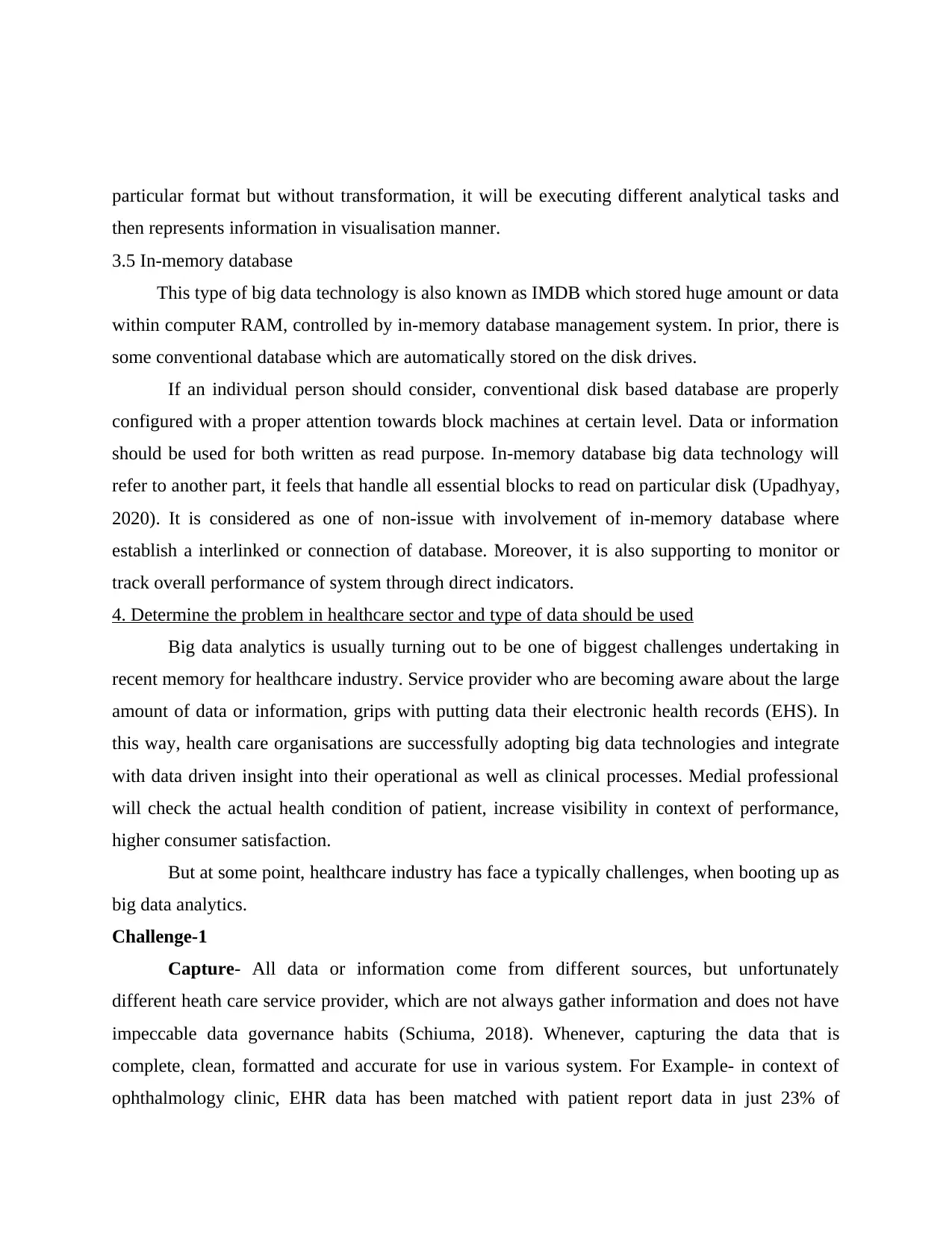
particular format but without transformation, it will be executing different analytical tasks and
then represents information in visualisation manner.
3.5 In-memory database
This type of big data technology is also known as IMDB which stored huge amount or data
within computer RAM, controlled by in-memory database management system. In prior, there is
some conventional database which are automatically stored on the disk drives.
If an individual person should consider, conventional disk based database are properly
configured with a proper attention towards block machines at certain level. Data or information
should be used for both written as read purpose. In-memory database big data technology will
refer to another part, it feels that handle all essential blocks to read on particular disk (Upadhyay,
2020). It is considered as one of non-issue with involvement of in-memory database where
establish a interlinked or connection of database. Moreover, it is also supporting to monitor or
track overall performance of system through direct indicators.
4. Determine the problem in healthcare sector and type of data should be used
Big data analytics is usually turning out to be one of biggest challenges undertaking in
recent memory for healthcare industry. Service provider who are becoming aware about the large
amount of data or information, grips with putting data their electronic health records (EHS). In
this way, health care organisations are successfully adopting big data technologies and integrate
with data driven insight into their operational as well as clinical processes. Medial professional
will check the actual health condition of patient, increase visibility in context of performance,
higher consumer satisfaction.
But at some point, healthcare industry has face a typically challenges, when booting up as
big data analytics.
Challenge-1
Capture- All data or information come from different sources, but unfortunately
different heath care service provider, which are not always gather information and does not have
impeccable data governance habits (Schiuma, 2018). Whenever, capturing the data that is
complete, clean, formatted and accurate for use in various system. For Example- in context of
ophthalmology clinic, EHR data has been matched with patient report data in just 23% of
then represents information in visualisation manner.
3.5 In-memory database
This type of big data technology is also known as IMDB which stored huge amount or data
within computer RAM, controlled by in-memory database management system. In prior, there is
some conventional database which are automatically stored on the disk drives.
If an individual person should consider, conventional disk based database are properly
configured with a proper attention towards block machines at certain level. Data or information
should be used for both written as read purpose. In-memory database big data technology will
refer to another part, it feels that handle all essential blocks to read on particular disk (Upadhyay,
2020). It is considered as one of non-issue with involvement of in-memory database where
establish a interlinked or connection of database. Moreover, it is also supporting to monitor or
track overall performance of system through direct indicators.
4. Determine the problem in healthcare sector and type of data should be used
Big data analytics is usually turning out to be one of biggest challenges undertaking in
recent memory for healthcare industry. Service provider who are becoming aware about the large
amount of data or information, grips with putting data their electronic health records (EHS). In
this way, health care organisations are successfully adopting big data technologies and integrate
with data driven insight into their operational as well as clinical processes. Medial professional
will check the actual health condition of patient, increase visibility in context of performance,
higher consumer satisfaction.
But at some point, healthcare industry has face a typically challenges, when booting up as
big data analytics.
Challenge-1
Capture- All data or information come from different sources, but unfortunately
different heath care service provider, which are not always gather information and does not have
impeccable data governance habits (Schiuma, 2018). Whenever, capturing the data that is
complete, clean, formatted and accurate for use in various system. For Example- in context of
ophthalmology clinic, EHR data has been matched with patient report data in just 23% of
Paraphrase This Document
Need a fresh take? Get an instant paraphrase of this document with our AI Paraphraser
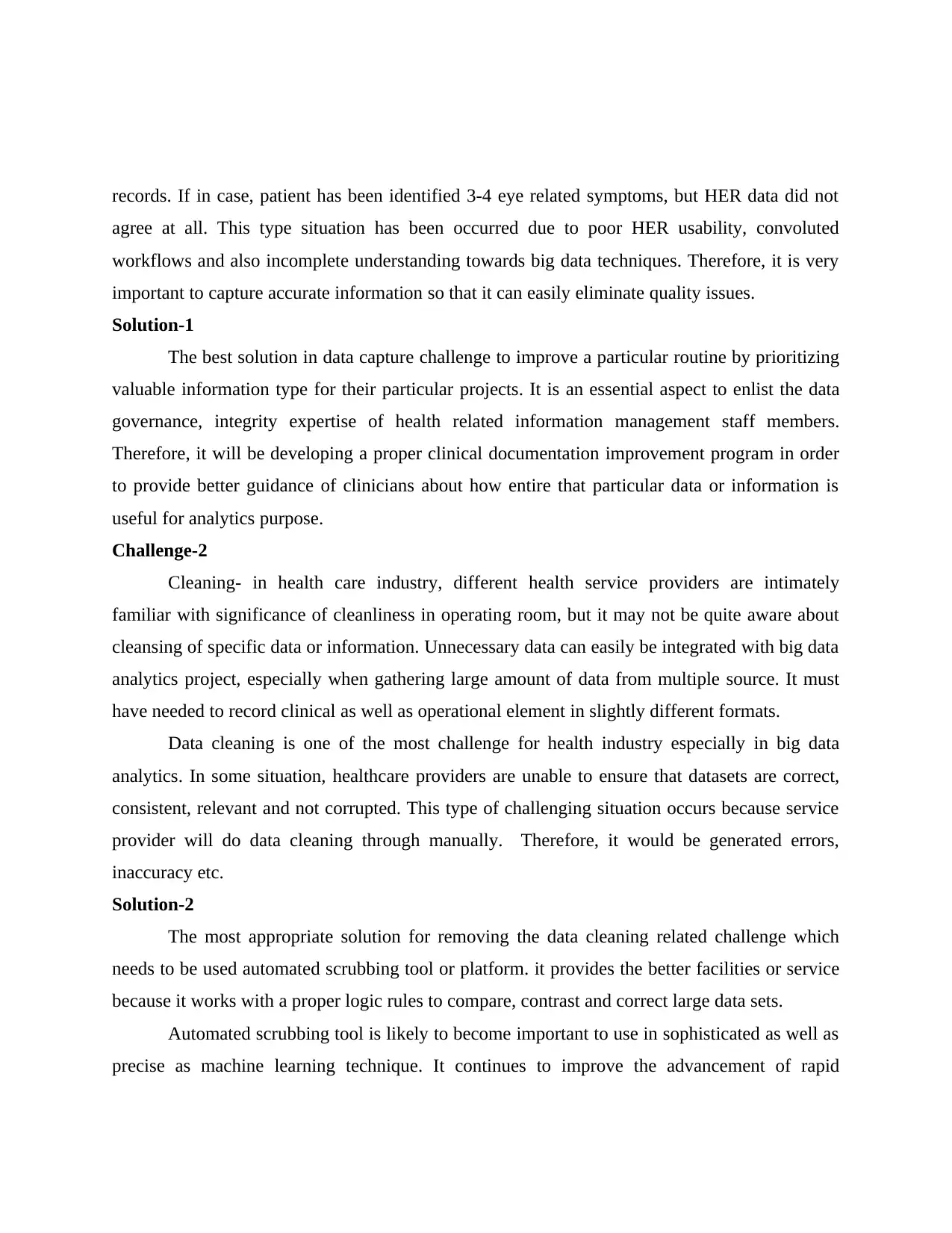
records. If in case, patient has been identified 3-4 eye related symptoms, but HER data did not
agree at all. This type situation has been occurred due to poor HER usability, convoluted
workflows and also incomplete understanding towards big data techniques. Therefore, it is very
important to capture accurate information so that it can easily eliminate quality issues.
Solution-1
The best solution in data capture challenge to improve a particular routine by prioritizing
valuable information type for their particular projects. It is an essential aspect to enlist the data
governance, integrity expertise of health related information management staff members.
Therefore, it will be developing a proper clinical documentation improvement program in order
to provide better guidance of clinicians about how entire that particular data or information is
useful for analytics purpose.
Challenge-2
Cleaning- in health care industry, different health service providers are intimately
familiar with significance of cleanliness in operating room, but it may not be quite aware about
cleansing of specific data or information. Unnecessary data can easily be integrated with big data
analytics project, especially when gathering large amount of data from multiple source. It must
have needed to record clinical as well as operational element in slightly different formats.
Data cleaning is one of the most challenge for health industry especially in big data
analytics. In some situation, healthcare providers are unable to ensure that datasets are correct,
consistent, relevant and not corrupted. This type of challenging situation occurs because service
provider will do data cleaning through manually. Therefore, it would be generated errors,
inaccuracy etc.
Solution-2
The most appropriate solution for removing the data cleaning related challenge which
needs to be used automated scrubbing tool or platform. it provides the better facilities or service
because it works with a proper logic rules to compare, contrast and correct large data sets.
Automated scrubbing tool is likely to become important to use in sophisticated as well as
precise as machine learning technique. It continues to improve the advancement of rapid
agree at all. This type situation has been occurred due to poor HER usability, convoluted
workflows and also incomplete understanding towards big data techniques. Therefore, it is very
important to capture accurate information so that it can easily eliminate quality issues.
Solution-1
The best solution in data capture challenge to improve a particular routine by prioritizing
valuable information type for their particular projects. It is an essential aspect to enlist the data
governance, integrity expertise of health related information management staff members.
Therefore, it will be developing a proper clinical documentation improvement program in order
to provide better guidance of clinicians about how entire that particular data or information is
useful for analytics purpose.
Challenge-2
Cleaning- in health care industry, different health service providers are intimately
familiar with significance of cleanliness in operating room, but it may not be quite aware about
cleansing of specific data or information. Unnecessary data can easily be integrated with big data
analytics project, especially when gathering large amount of data from multiple source. It must
have needed to record clinical as well as operational element in slightly different formats.
Data cleaning is one of the most challenge for health industry especially in big data
analytics. In some situation, healthcare providers are unable to ensure that datasets are correct,
consistent, relevant and not corrupted. This type of challenging situation occurs because service
provider will do data cleaning through manually. Therefore, it would be generated errors,
inaccuracy etc.
Solution-2
The most appropriate solution for removing the data cleaning related challenge which
needs to be used automated scrubbing tool or platform. it provides the better facilities or service
because it works with a proper logic rules to compare, contrast and correct large data sets.
Automated scrubbing tool is likely to become important to use in sophisticated as well as
precise as machine learning technique. It continues to improve the advancement of rapid

performance and also helps to reduce the time, ensure high level of accuracy and integrity in
healthcare data warehouses.
healthcare data warehouses.
⊘ This is a preview!⊘
Do you want full access?
Subscribe today to unlock all pages.

Trusted by 1+ million students worldwide
1 out of 17
Related Documents
Your All-in-One AI-Powered Toolkit for Academic Success.
+13062052269
info@desklib.com
Available 24*7 on WhatsApp / Email
![[object Object]](/_next/static/media/star-bottom.7253800d.svg)
Unlock your academic potential
Copyright © 2020–2025 A2Z Services. All Rights Reserved. Developed and managed by ZUCOL.





